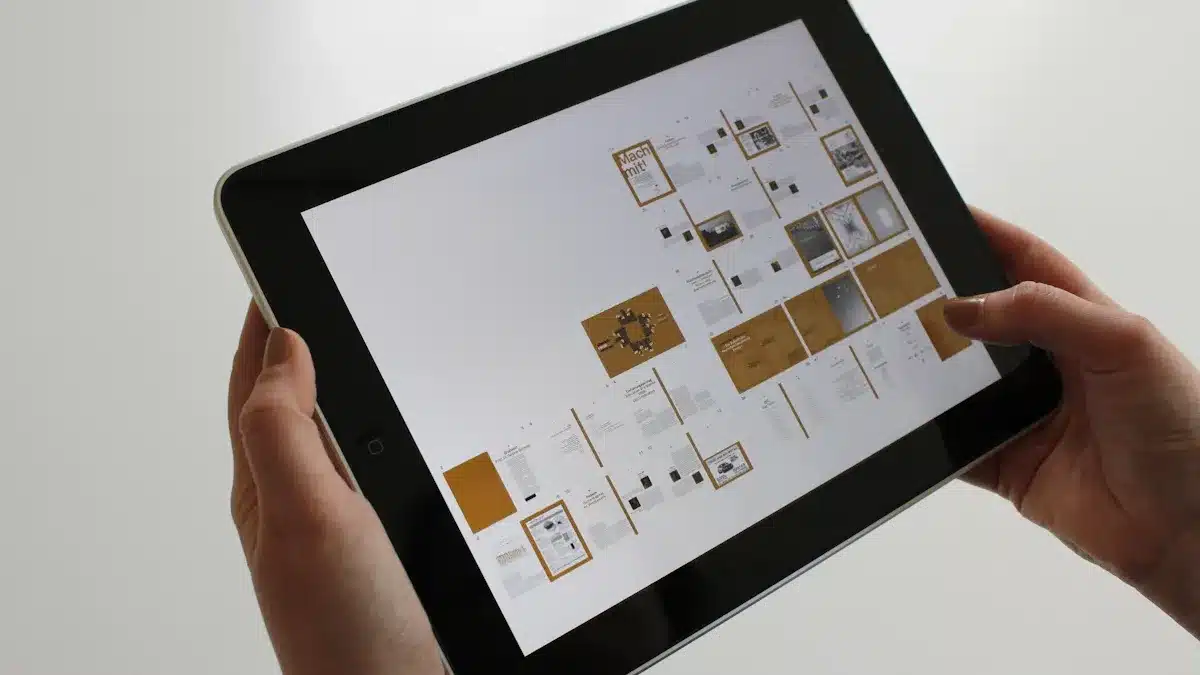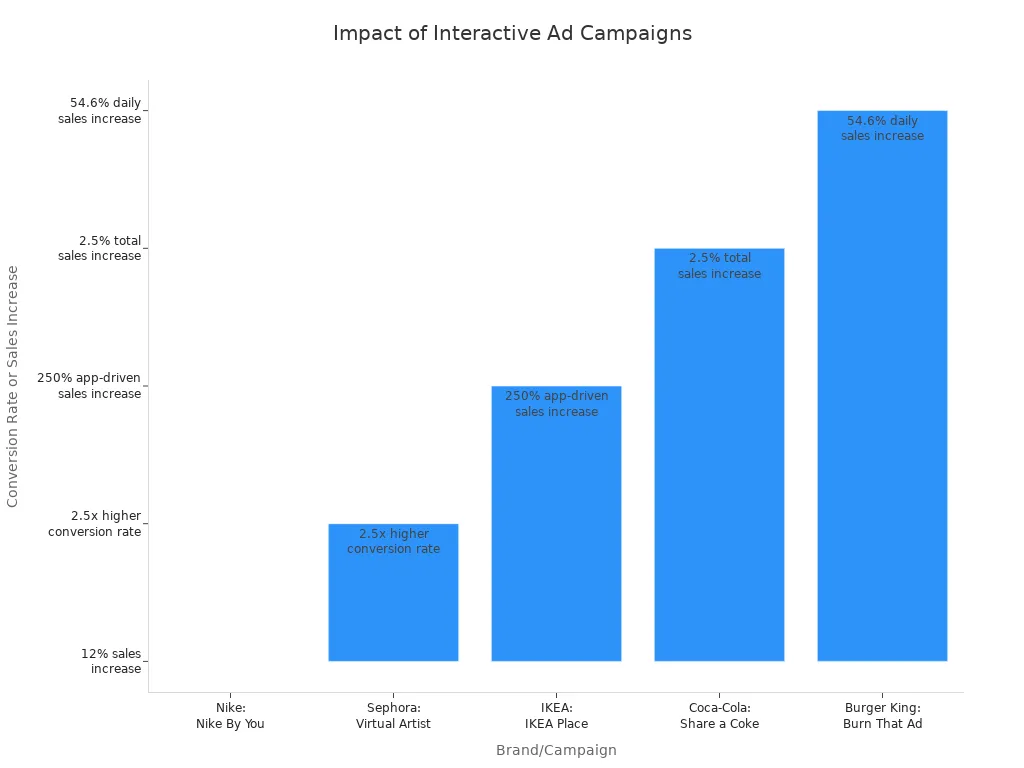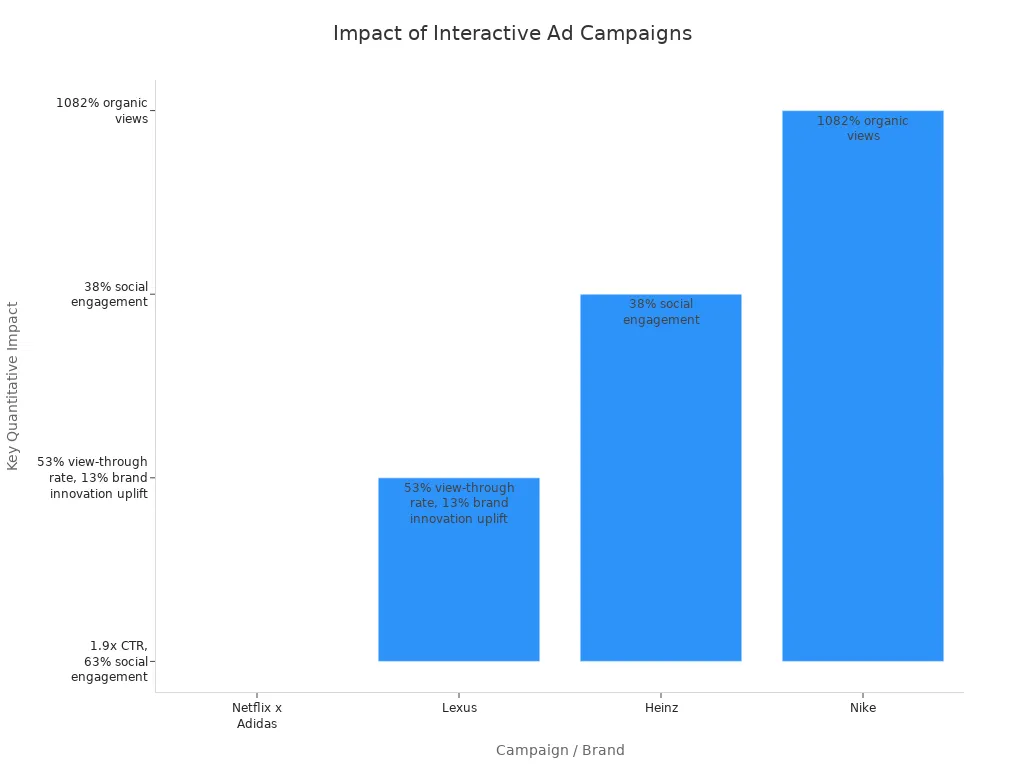
.Interactive ad interfaces 35 allow users to actively participate in marketing activities. These .Interactive ad interfaces 35 use quizzes, polls, games, and dynamic visuals that respond to taps, swipes, or clicks. Brands leverage .Interactive ad interfaces 35 to boost engagement and drive higher sales. Research shows that AR-based .Interactive ad interfaces 35 can double visual attention and improve product recall. Marketers have found that campaigns featuring micro-animations and virtual try-ons through .Interactive ad interfaces 35 are highly effective. These features encourage users to spend more time with the brand and increase brand awareness. Additionally, .Interactive ad interfaces 35 enable companies to gather detailed data and deliver personalized marketing messages.
Key Takeaways
Interactive ad interfaces let people join ads by doing quizzes, games, and AR. This makes ads more fun and easy to remember. These ads help people pay more attention. They help people remember the brand better. They can also help brands sell more by making people spend more time with them. New technology like AI and adaptive design makes ads fit each person. It also helps ads work well on every device. Interactive ads give feedback right away. They also collect helpful data. This helps brands make their marketing better and faster. To do well, brands should make ads simple and clear. They should also make ads easy to use on phones. Brands should test their ads a lot. They should make sure people enjoy using them.
Interactive Ad Interfaces

What They Are
Interactive ad interfaces are the base of interactive advertising. These interfaces ask users to join in with the ad. This turns people from just watching into doing something. Brands use interactive ads to make digital experiences that are fun and easy to remember.
Some common things you see in interactive ads are:
Quizzes that ask questions and give answers right away.
Polls where users vote and see results quickly.
Games that let users play and win rewards.
Augmented reality (AR) filters for trying products online.
Interactive videos with spots you can click for more info or choices.
Playable ads that let users try a product in the ad.
Social media ads with carousels, stories you can swipe, and challenges.
Big brands use these types of ads in their online campaigns. For example, quizzes and AR filters show up a lot on social media and in emails. Companies like Burberry use image carousels in emails. Tesla lets people build cars inside an email. These ads make people feel like they are part of the brand and spend more time with it.
Interactive advertising is special because it needs people to take part. The ad changes for each person, so it feels personal. Interactive media advertising also collects helpful data from every click or tap. This helps brands make better ads later. Good pictures, mobile-friendly design, and easy-to-use features make the experience smooth for everyone.
How They Work
Interactive ads depend on what users do. People might click, swipe, or tap on parts of the ad. Each move makes the ad do something new. This makes the digital experience feel real and fun.
The steps behind interactive advertising are:
The user does something, like clicking or swiping.
The ad interface sees this and follows certain rules. For example, a swipe might start an animation or show new stuff.
The system gives feedback. This could be a color change, a sound, or a vibration.
The ad might change based on what the user does, making it feel different for everyone.
Interactive media advertising uses clear signs, like buttons or moving hints, to show where to interact. These signs help users know what to do. If the design does not have clear clues, people might leave before trying the ad.
Modern tech helps make digital interactive ads work. JavaScript tools like React and Vue.js help build fast and cool interfaces. AJAX lets ads change without reloading the page, so things stay smooth. Artificial intelligence (AI) and machine learning make the ad fit each user by looking at their data. Adaptive user interfaces change how things look and work based on what the user does, so everyone has a good time.
Interactive videos are important in interactive advertising. These videos let users pick choices, click on products, or follow different stories. Interactive videos are used a lot in digital campaigns because they mix stories with user actions. Brands use interactive videos to get people interested and learn more about them.
Interactive advertising works well because it gives feedback right away. When people use digital interactive ads, they get instant answers. This makes them want to keep going and can lead to more sales. Interactive media advertising uses these quick responses to make the experience better and help people feel closer to the brand.
Tip: Interactive ads are best when they are easy and fun. Brands should test their interactive media advertising on many devices to make sure everyone has a good experience.
Interactive Advertising vs. Traditional Ads
Engagement Differences
Interactive advertising is different because it gets people involved. Traditional ads just show a message and hope you watch or listen. Interactive ads ask you to click, swipe, play games, or answer quizzes. This makes people pay more attention and feel closer to the brand.
Interactive ads need you to join in, so you spend more time with them.
People spend longer on interactive ads, which helps them remember the brand.
Games and quizzes in interactive ads make brands easier to remember.
Click-through rates go up because interactive parts catch your eye.
Fun experiences in interactive ads make people want to buy things.
Personalization in interactive ads makes each ad fit you better.
Interactive ads teach you about products, so you feel sure about your choices.
Aspect | Interactive Ads | Traditional Ads |
|---|---|---|
User Involvement | Active (gamification, quizzes, AR, polls) | Passive (one-way communication) |
Time Spent on Ads | Lower time spent | |
Engagement Rate Increase | Nearly 6% higher engagement rates | Lower engagement rates |
Click-Through Rate (CTR) | Up to 28.8% | Around 3.9% |
Brand Recall | Twice as likely to remember brand after interaction | Lower brand recall |
Feedback & Personalization | Real-time feedback, personalized experiences | Lacks real-time feedback and personalization |
Conversion Rates | Higher conversion rates due to engagement | Lower conversion rates |
Interactive media advertising uses things like games and AR to keep people interested. The interactive parts make people want to share ads with friends. Spending more time and joining in makes interactive ads work better than regular ads.
User Experience
Interactive advertising lets people control what happens. Instead of just watching, you can pick how you want to use the ad. This makes ads more fun and easy to remember. Interactive ads on streaming sites let you choose when and how to join in, so ads feel like an event.
Brands say interactive ads get people to join in more and stay longer. For example, interactive media advertising keeps people interested three to seven times longer than regular ads. Features like AR try-ons or playable ads make ads feel like games, not something boring. This helps people not get tired of ads and keeps them interested.
Interactive advertising also collects lots of data from inside the ad. Brands can see what people do with every part of the ad. This quick feedback helps marketers change ads fast and send better messages. Regular ads use big surveys and do not see what each person does. Interactive media advertising shows brands how people join in and helps them make better ads.
Note: Interactive ads change marketing by making every click matter. Brands that use interactive advertising get more people to join in, better data, and stronger connections with their audience.
Types of Interactive Ads

Formats
Interactive ads have many different formats. Each format helps brands make ads that people want to join in. The table below shows some popular types of interactive ads used today:
Type of Interactive Ad | Description | Benefits / Metrics | Common Platforms / Usage Contexts |
|---|---|---|---|
Interactive Shoppable Ads | Users buy things in the ad with buttons. | Raises sales by about 30%. | Instagram, Facebook, Pinterest |
Interactive Games | Fun games or demos inside ads. | Gets users to join in directly. | Mobile apps, Websites |
Interactive Videos | Users pick products or stories in the video. | 13 times more clicks, 50 times more CTAs. | YouTube, Social Media, Mobile Apps |
Interactive Display Banners | Banners with games, moving parts, or clickable spots. | More lively than regular banners. | Websites, Mobile Apps |
Interactive Stories | Story ads with polls, questions, or swipe-ups. | Boosts user feedback and joining in. | Instagram, Snapchat, AR & VR apps |
Interactive CTVs | TV ads with extra layers and carousels. | More fun than normal TV ads. | Apple TV, Roku, Amazon Fire TV |
Interactive Web Apps | Chatbots and AI help users with questions and buying. | Talks with customers in a friendly way. | Websites, WhatsApp, Mobile Apps |
Interactive campaigns use these formats to get people to take part. Playable ads let users try a product or play a small game. This makes the ad fun and easy to remember. Polls and quizzes ask what people think, so users share their ideas. Augmented reality ads show products in your space, making it feel real. Interactive audio ads let people answer with their voice or reply to questions, making ads feel more personal.
Tip: Interactive campaigns with games, quick prizes, and sharing features keep people interested longer and help them remember the brand.
Technology
Interactive campaigns use new technology to make ads exciting. Playable ads use Google AdMob and Unity Ads to make games that work well on phones. Interactive video ads use virtual reality and augmented reality to build cool digital worlds. These tools let users touch and use products right away.
Artificial intelligence and data analytics help make interactive ads fit each person. Brands change ads based on what users do, so every ad feels special. Haptic feedback lets users feel shakes or moves during audio ads or games. Interactive campaigns also use chatbots to help users, answer questions, and suggest products.
Interactive campaigns with these tools get more people to join in and give better results. Adding games and rewards makes users want to keep playing. This helps brands build trust and makes interactive ads stand out online.
Benefits and Challenges
Advantages
Interactive ad interfaces have many good points for brands. These ads give each user a special experience. People see things that match what they like. This makes them want to join in more. Interactive ads get over 50% more attention than regular ads. They also lead to twice as many sales. Brands like Nike, Sephora, and IKEA saw big jumps in sales and customer interest after using these ads.

Interactive ads help brands get better data. Marketers can see every click, swipe, or tap. This helps them learn what users like and how they act. Interactive dashboards and AI tools make it easy to find patterns and make ads better. Brands can fix problems fast and make smart choices. These tools help brands get more sales, better brand recall, and loyal customers. Many brands say they get twice as many sales and up to 50% more clicks with these ads.
Note: Interactive ads let users feel in control and help them remember the brand.
Drawbacks
Interactive ad interfaces have some problems too. Making these ads takes more time and costs more money than regular ads. Developers need special skills in AI, machine learning, and design. Brands must make sure the ads work on all devices, like phones and tablets. If the ad is not easy to use, people may leave before finishing.
Some brands find it hard to keep their brand voice the same in different ad formats. They also need to teach users how to use new things, like voice or chatbots. If the ad feels confusing or slow, people stop using it. Marketers must test and watch how people use the ads to fix problems fast. Technical problems, like slow loading or bad speech recognition, can make the ad worse. Brands need to be creative but also make ads easy to use so people stay interested.
Creating Effective .interactive ad interfaces 35 Campaigns
Steps
To make a good .interactive ad interfaces 35 campaign, you need to plan well. Marketers should use a simple process to help the campaign reach its goals and connect with the right people.
Set clear goals you can measure, like getting more clicks or tracking sales.
Split the audience into groups by what they like and need. Make buyer personas to learn what makes users interested.
Pick the best places for the campaign. Choose where your audience spends time, like social media or apps.
Make a budget that works. Use your money in smart ways to get the most from the campaign.
Create fun content with strong pictures, easy words, and a clear call to action. Add personal touches so each user feels special.
Use different types of content. Add quizzes, games, and interactive videos to reach more people.
Build a team with the right skills. Give jobs for planning, design, writing, and checking data.
Test parts of the campaign with A/B testing and get feedback. Change the .interactive ad interfaces 35 if users want something different.
Plan when to launch, like during big events or new product times. Use soft launches and online events to get people excited.
Watch how the campaign does after it starts. Use real-time data to make changes and get better results.
Tip: Marketers should use tools like Google Analytics to track clicks, sales, and engagement for each campaign.
Best Practices
Top brands use smart ways to make .interactive ad interfaces 35 work better. The table below shows how different platforms set up interactive campaigns to get more people involved:
Platform | Strategy/Feature | User Engagement Approach | Benefit |
|---|---|---|---|
Adventr | Branching video scenarios | User controls narrative | Immersive experience |
Amuse Labs | Gamified quizzes and puzzles | Game-like challenges | Longer brand interaction |
ConvertCalculator | Personalized calculators | Instant, tailored results | Lead generation |
Shuttlerock | Mobile-optimized, user content | Mobile-first interactive ads | Authentic engagement |
To get the best results, marketers should:
Add interactive things like clickable spots and mini-games to get more people to join in.
Make content personal for each user to help them care and buy more.
Make sure .interactive ad interfaces 35 work well on all devices, like phones and computers.
Do not use too many moving parts so the message stays clear.
Put clear calls to action and test if they work well.
Keep an eye on important numbers like click-through rate and sales to help make the campaign better.
Note: Testing often and using data to make changes helps interactive campaigns work well in digital marketing.
Interactive ad interfaces change digital marketing by making ads fun and easy to remember. These ads are also made just for you. Marketers notice people join in more and stick with the brand when they use these tools. The table below shows how big brands get great results with interactive campaigns:
Campaign / Brand | Key Takeaways / Learnings | Quantitative Impact Highlights |
|---|---|---|
Netflix x Adidas “Stranger Things” | AI-powered personalization, real-time creative optimization, storytelling with retail | 1.9x higher CTR; sold out in <24h; 63% higher social engagement |
Lexus “Driven by Intuition” | AI for scriptwriting, tech-driven storytelling, innovation differentiation | Millions of views; 13% brand innovation uplift; 53% higher view-through rate |
Heinz A.I. Ketchup | AI visuals, interactive social media, cultural relevance | 850M+ impressions; 38% higher social engagement; global participation |
Nike “Never Done Evolving” | AI storytelling, virtual simulation, innovation | 1.7M YouTube viewers; 1082% organic view increase |

The future of interactive advertising will use more AI and new tech. Brands will connect ads across different places and make them feel real. Companies that use these new ideas will give people what they want. People want ads that feel personal and safe. The future of interactive advertising will help brands keep loyal customers, sell more, and build strong relationships.
FAQ
What makes interactive ads different from regular ads?
Interactive ads let people do things, like click or swipe. Regular ads just show you stuff. Interactive ads answer back and make you join in. This helps people remember the brand more.
Can interactive ads work on all devices?
Most interactive ads work on phones, tablets, and computers. Brands use special tools so ads look good everywhere. Testing on many devices helps find problems before ads start.
How do brands measure success with interactive ads?
Brands count clicks, time spent, and what people do in the ad. They use this data to see what works best. This helps them make better ads and reach more people.
Are interactive ads safe for user privacy?
Brands follow privacy rules and keep user data safe. They only collect what is needed for the ad. Users often see privacy notices or can pick what to share.
See Also
Comparing Wireless CarPlay Adapters And AI Boxes For Value
Understanding Wireless CarPlay Adapters And Their Driving Benefits
The Impact Of G37 Apple CarPlay Adapters On Driving
